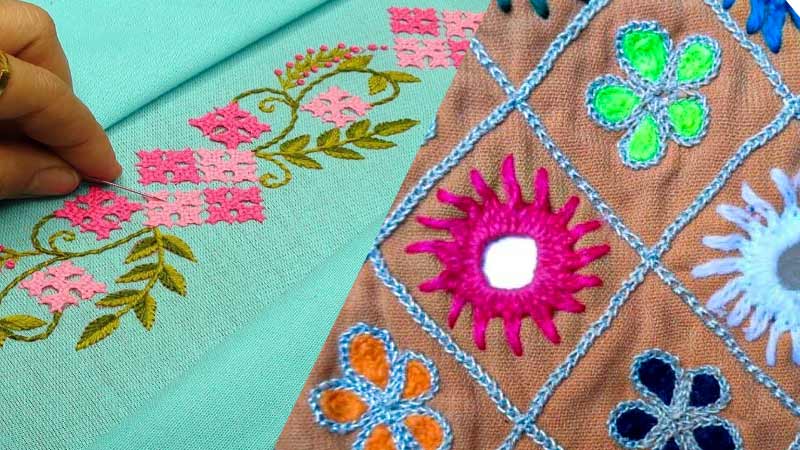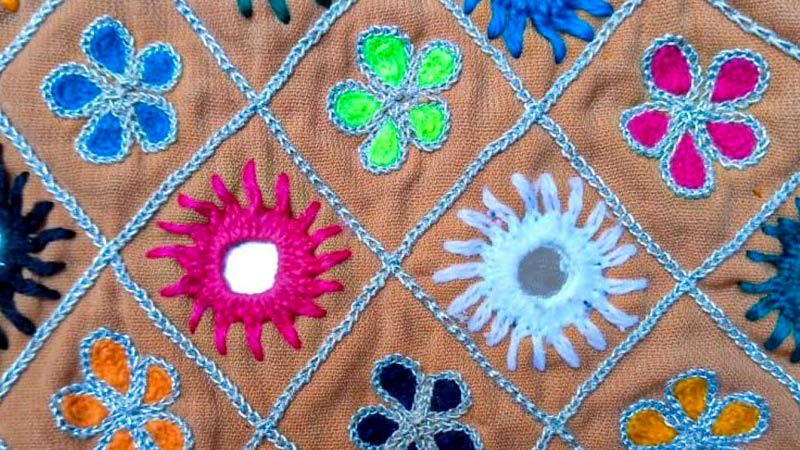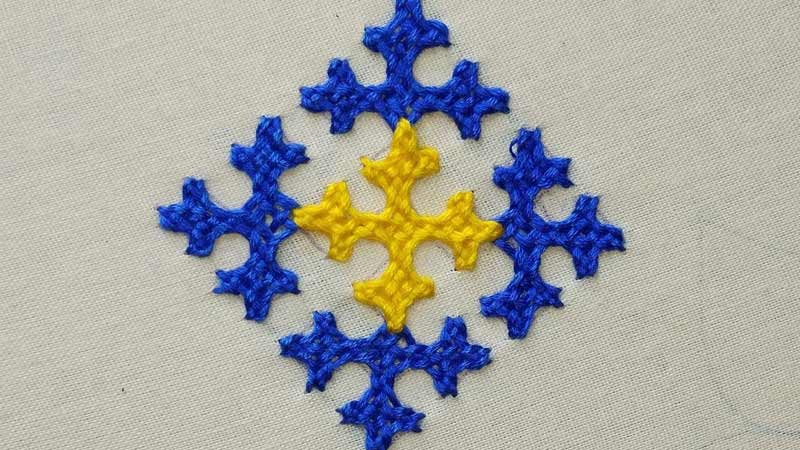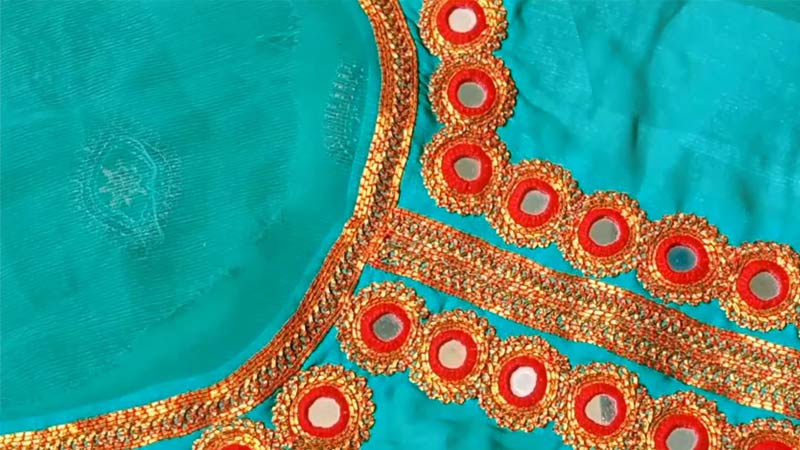Sindhi and Balochi mirror embroidery, steeped in rich cultural traditions, are renowned forms of textile artistry originating from the Sindh region of Pakistan and Balochistan, respectively.
This unique craft involves meticulously placing reflective glass or mirrors onto fabric, creating dazzling and vibrant patterns.
Known by various names, Sindhi mirror embroidery is often referred to as “Sheesha work” or “Abhla Bharat,” showcasing intricate designs that reflect the cultural heritage of the Sindhi people.
On the other hand, Balochi mirror embroidery, specific to the Balochi community, highlights its own distinctive patterns and styles.
Together, these embroidery forms serve as artistic expressions and embody the cultural identity and traditions of their respective regions.

What Is Mirror Work Embroidery?
Mirrorwork embroidery, often referred to as “Shisha” or “Abhla Bharat,” is a traditional Indian craft that involves the meticulous embellishment of fabric with small pieces of reflective glass or mirrors.
Mirrorwork embroidery is characterized by strategically placing these reflective elements on the fabric, creating a dazzling interplay of light and color.
Artisans skillfully incorporate these mirrors into intricate and vibrant designs, ranging from geometric patterns to floral motifs.
The mirrors are typically secured to the fabric using colorful threads, enhancing the embroidery’s aesthetic appeal and structural integrity.
This centuries-old craft has deep cultural roots in India and is commonly found in traditional clothing, home decor items, and accessories.
Mirrorwork embroidery not only showcases the rich artistic heritage of India but also exemplifies the meticulous craftsmanship and attention to detail inherent in this form of textile embellishment.
What Is Sindhi And Balochi Mirror Embroidery Called?
Sindhi mirror embroidery, also known as “Sheesha work,” is a distinctive traditional craft originating from the Sindh region of Pakistan.
This unique form of Sindhi embroidery involves meticulously incorporating small pieces of reflective glass or mirrors onto fabric, creating an enchanting play of light and color.
The mirrors are carefully stitched onto the fabric, often forming intricate geometric patterns, floral motifs, and other traditional designs.
The vibrant and bold colors and the reflective elements make Sindhi mirror embroidery a visually striking and culturally significant art form.
Similarly, Balochi mirror embroidery, prevalent in the Balochistan region, shares similarities with Sindhi mirror work.
It involves the skillful arrangement of mirrors on fabric, showcasing the Balochi people’s rich cultural heritage and craftsmanship.
Both Sindhi and Balochi mirror embroidery represent artistic expression and a connection to the cultural roots and traditions of the respective regions.
Types Of Mirror Work Embroidery
Mirrorwork embroidery encompasses a rich tapestry of techniques and styles, each contributing to the vibrant heritage of traditional crafts.
Here, we delve into seven distinct types of mirrorwork embroidery, celebrating this craft’s diverse artistry and cultural significance.
1. Sindhi Mirror Embroidery

Originating from the Sindh region in Pakistan, Sindhi mirror embroidery is characterized by its meticulous placement of small mirrors on fabric. This technique often incorporates vibrant colors and intricate patterns, reflecting the rich cultural heritage of the Sindhi people.
From geometric designs to floral motifs, Sindhi mirror embroidery is a testament to the skill and artistry of the artisans.
2. Balochi Mirror Embroidery
Hailing from Balochistan, Balochi mirror embroidery shares similarities with Sindhi mirror work. This style, specific to the Balochi community, features mirrors skillfully arranged on fabric, creating visually captivating designs.
Balochi mirror embroidery serves as a form of artistic expression and represents the cultural identity and traditions of the Balochi people.
3. Abhla Bharat Embroidery
Also known as the “mirror work of Gujarat,” Abhla Bharat embroidery is a traditional craft from the western state of India. This technique involves using small, round mirrors encased in metal and then stitched onto the fabric.
The mirrors are arranged in patterns, often forming intricate designs inspired by nature, folklore, and traditional motifs.
4. Pakko Embroidery
Hailing from the Kutch region of Gujarat, Pakko embroidery is a unique style incorporating mirrors and vibrant threads and sequins. The mirrors are fixed into the fabric using a satin stitch, creating a raised and textured surface.
This form of mirror work is often seen in the traditional attire of the Kutchi community, reflecting their cultural aesthetics.
5. Rabari Embroidery

Another noteworthy style from Gujarat, Rabari embroidery, features mirrors surrounded by intricate threadwork. The mirrors are often set within geometric shapes and surrounded by vibrant embroidery, creating a visually dynamic and harmonious composition.
Rabari mirror work is a significant part of the cultural identity of the Rabari community in Gujarat.
6. Kathi Embroidery
Originating from the Kathiawar region of Gujarat, Kathi embroidery involves the use of mirrors alongside colorful threads. This style is characterized by bold and geometric designs, with mirrors often placed strategically to enhance the overall visual impact.
Kathi embroidery is a testament to the region’s cultural richness and the skill of its artisans.
6. Rajasthani Mirror Embroidery
Rajasthan, known for its rich textile heritage, boasts a unique form of mirrorwork embroidery. In Rajasthani mirror embroidery, mirrors are often surrounded by vibrant threadwork and complemented by intricate beadwork.
This style reflects the cultural vibrancy of Rajasthan, with designs inspired by the state’s folklore, architecture, and nature.
These seven types of mirrorwork embroidery highlight this traditional craft’s diverse regional influences, design aesthetics, and cultural stories.
Each style not only showcases the artisans’ skill but also preserves the cultural heritage of the communities practicing these distinctive forms of embroidery.
Trendy Sindhi Mirror Work Design

Shisha embroidery, commonly known as Sindhi mirror work, has evolved over the years, seamlessly blending tradition with contemporary trends.
Here, we explore seven trendy Sindhi mirror work designs that capture the essence of modern fashion while preserving the cultural heritage of this exquisite craft.
Fusion Elegance
This design seamlessly integrates Sindhi mirror work into contemporary silhouettes, such as asymmetrical hemlines and unconventional cuts.
The mirrors are strategically placed to add a touch of glamour to the outfit, making it perfect for both traditional and modern occasions.
Bohemian Bliss
Embracing the bohemian spirit, this Sindhi mirror work design features mirrors adorned on flowy, free-spirited garments.
Whether on maxi dresses or loose-fitting tops, the mirrors complement the boho-chic aesthetic, creating a fusion of cultural richness and casual elegance.
Monochrome Magic
Breaking away from the traditional burst of colors, this design focuses on a monochrome palette, where mirrors are set against black or white fabric.
This contemporary take on Sindhi mirror work exudes sophistication and versatility, making it suitable for various formal and semi-formal events.
Geometric Glam
Playing with geometric shapes, this design incorporates mirrors in modern patterns, creating a visually striking and dynamic effect.
Whether on blouses, jackets, or accessories, the geometric glam Sindhi mirror work design adds a touch of avant-garde appeal to any ensemble.
Minimalist Marvel
Embracing the less-is-more philosophy, this Sindhi mirror work design features a minimalist approach, with mirrors delicately scattered on a clean canvas.
This design aesthetic caters to those who appreciate subtlety and sophistication, allowing the craftsmanship to shine through without overwhelming the outfit.
Contemporary Saree Edge
This design elevates the classic saree by adorning the saree borders with Sindhi mirror work. The mirrors add a contemporary twist to the traditional garment, making it a perfect choice for modern, fashion-forward occasions while preserving the elegance of the saree.
Statement Accessories
This Sindhi mirror work design extends beyond clothing to accessories like clutches, belts, and footwear. Mirrors are intricately incorporated into these accessories, transforming them into statement pieces that effortlessly elevate any ensemble, providing a stylish nod to Sindhi craftsmanship.
These seven trendy Sindhi mirror work designs showcase the versatility of this traditional craft, proving that Shisha embroidery can seamlessly adapt to the ever-changing landscape of fashion.
Whether embracing bohemian vibes, experimenting with geometric patterns, or opting for minimalist elegance, these designs celebrate the enduring beauty of Sindhi mirror work in the contemporary world.
FAQs
What is Balochi mirror embroidery called?
Balochi mirror embroidery is known by its regional name and is specific to the Balochi community. This traditional craft, originating from Balochistan, features skillfully arranged mirrors on fabric, reflecting the Balochi people’s unique cultural identity and artistic traditions.
Are there other names for Sindhi mirror embroidery?
Yes, besides “Sheesha work” and “Abhla Bharat,” Sindhi mirror embroidery is also known as Sindhi mirror work. These names are used interchangeably to describe the intricate art of embellishing fabric with small reflective mirrors.
How does Sindhi mirror embroidery differ from Balochi mirror embroidery?
Sindhi mirror embroidery and Balochi mirror embroidery have distinct regional styles. Sindhi mirror work often incorporates vibrant colors and intricate patterns, while Balochi mirror embroidery showcases unique designs specific to the Balochi community.
Can Sindhi mirror embroidery be worn in contemporary fashion?
Absolutely. Sindhi mirror embroidery has seamlessly transitioned into contemporary fashion. Designers often incorporate this traditional craft into modern silhouettes, creating trendy and fashionable attire that pays homage to the rich cultural heritage of Sindhi mirror work.
Is Balochi mirror embroidery only found in clothing?
No, Balochi mirror embroidery extends beyond clothing. Mirrors are skillfully incorporated into various traditional accessories, such as belts, bags, and footwear, transforming these items into statement pieces.
This showcases the versatility of Balochi mirror work beyond fabric and its integration into diverse elements of personal adornment.
Conclusion
Sindhi and Balochi mirror embroidery is a testament to the enduring legacy of textile craftsmanship in the Indian subcontinent.
These intricate art forms, known by different names, encapsulate the cultural richness and aesthetic sensibilities of the Sindhi and Balochi communities.
The amalgamation of tradition and artistic innovation becomes evident as we delve into the intricacies of Sindhi mirror embroidery and its Balochi counterpart.
These vibrant, reflective creations enhance the fabric and preserve centuries-old cultural narratives. The names associated with these mirror work techniques serve as a cultural beacon, guiding us through the diverse and captivating tapestry of South Asian textile heritage.
Leave a Reply